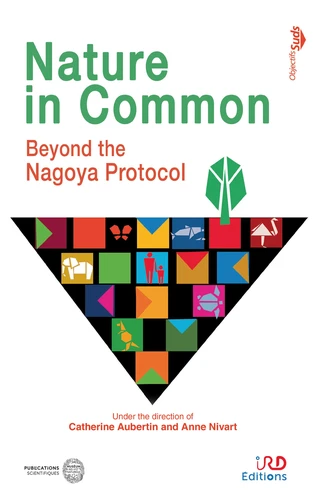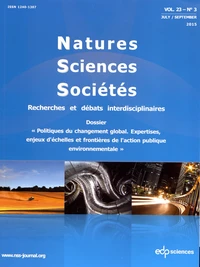Nature in Common. Beyond the Nagoya Protocol.
Par : ,Formats :
Disponible dans votre compte client Decitre ou Furet du Nord dès validation de votre commande. Le format Multi-format est :
- Pour les liseuses autres que Vivlio, vous devez utiliser le logiciel Adobe Digital Edition. Non compatible avec la lecture sur les liseuses Kindle, Remarkable et Sony
 , qui est-ce ?
, qui est-ce ?Notre partenaire de plateforme de lecture numérique où vous retrouverez l'ensemble de vos ebooks gratuitement
Pour en savoir plus sur nos ebooks, consultez notre aide en ligne ici
- Nombre de pages320
- FormatMulti-format
- ISBN978-2-7099-2946-2
- EAN9782709929462
- Date de parution21/07/2022
- Protection num.NC
- Infos supplémentairesMulti-format incluant PDF avec W...
- ÉditeurIRD Editions
Résumé
A landmark text in global biodiversity governance, the Nagoya Protocol was intended to put an end to the uncompensated exploitation of natural resources and knowledge originating in the Global South. Its stated objectives were to establish greater justice and equity between providers and users of genetic resources, to foreground the contributions and knowledge of indigenous peoples and local communities, and to decolonise research, all while promoting the conservation of biodiversity.
Thirty years on from the Convention on Biological Diversity from which it originated, the authors examine the legal and practical outcomes of this virtuous framework, which came into force in 2014. Although it has certainly fostered greater recognition of the plurality of knowledge and advanced the traceability of resources, the Protocol has also helped to impose a narrowly market-oriented understanding of nature and knowledge, exacerbating demands for recognition and ownership in the Global South, and effectively restricting access to biodiversity in an era of globalised research.
This book presents an interdisciplinary dialogue informed by the experiences of researchers and conservation stakeholders (local communities, managers of collections and natural parks). Looking beyond the Nagoya Protocol, it invites us to question the relationships between societies and nature in light of the ecological emergency. It is intended for anyone with an interest in the economics of biodiversity and environmental justice.
Thirty years on from the Convention on Biological Diversity from which it originated, the authors examine the legal and practical outcomes of this virtuous framework, which came into force in 2014. Although it has certainly fostered greater recognition of the plurality of knowledge and advanced the traceability of resources, the Protocol has also helped to impose a narrowly market-oriented understanding of nature and knowledge, exacerbating demands for recognition and ownership in the Global South, and effectively restricting access to biodiversity in an era of globalised research.
This book presents an interdisciplinary dialogue informed by the experiences of researchers and conservation stakeholders (local communities, managers of collections and natural parks). Looking beyond the Nagoya Protocol, it invites us to question the relationships between societies and nature in light of the ecological emergency. It is intended for anyone with an interest in the economics of biodiversity and environmental justice.
A landmark text in global biodiversity governance, the Nagoya Protocol was intended to put an end to the uncompensated exploitation of natural resources and knowledge originating in the Global South. Its stated objectives were to establish greater justice and equity between providers and users of genetic resources, to foreground the contributions and knowledge of indigenous peoples and local communities, and to decolonise research, all while promoting the conservation of biodiversity.
Thirty years on from the Convention on Biological Diversity from which it originated, the authors examine the legal and practical outcomes of this virtuous framework, which came into force in 2014. Although it has certainly fostered greater recognition of the plurality of knowledge and advanced the traceability of resources, the Protocol has also helped to impose a narrowly market-oriented understanding of nature and knowledge, exacerbating demands for recognition and ownership in the Global South, and effectively restricting access to biodiversity in an era of globalised research.
This book presents an interdisciplinary dialogue informed by the experiences of researchers and conservation stakeholders (local communities, managers of collections and natural parks). Looking beyond the Nagoya Protocol, it invites us to question the relationships between societies and nature in light of the ecological emergency. It is intended for anyone with an interest in the economics of biodiversity and environmental justice.
Thirty years on from the Convention on Biological Diversity from which it originated, the authors examine the legal and practical outcomes of this virtuous framework, which came into force in 2014. Although it has certainly fostered greater recognition of the plurality of knowledge and advanced the traceability of resources, the Protocol has also helped to impose a narrowly market-oriented understanding of nature and knowledge, exacerbating demands for recognition and ownership in the Global South, and effectively restricting access to biodiversity in an era of globalised research.
This book presents an interdisciplinary dialogue informed by the experiences of researchers and conservation stakeholders (local communities, managers of collections and natural parks). Looking beyond the Nagoya Protocol, it invites us to question the relationships between societies and nature in light of the ecological emergency. It is intended for anyone with an interest in the economics of biodiversity and environmental justice.













